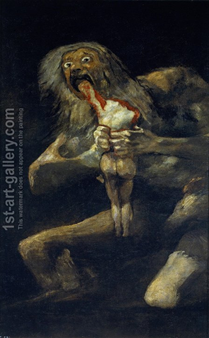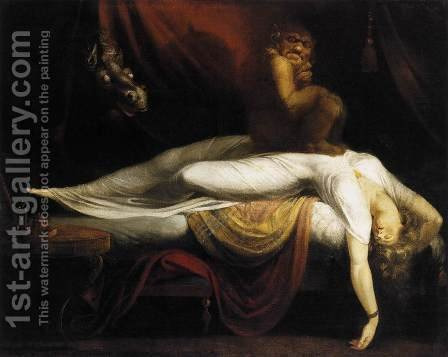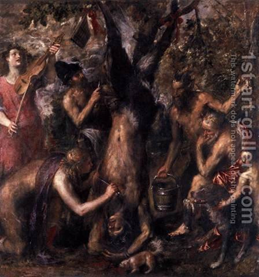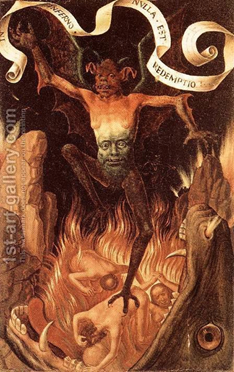An older man feasting on his son’s chest, a ghoul sitting atop a beautiful damsel while his white-eyed horse waits, or a pile of severed limbs! What do you think when you read or hear these scenes? Gruesome, terrifying, stone-cold brutal, right?
These are the descriptions of some of the most terrifying paintings mankind has ever seen. But, aren’t paintings meant to soothe our soul and calm the nerves? The beautiful picturesque scenes of glamour and fervor embellished with the shades of happiness and delight shadowing the characters.
Isn’t that how paintings are supposed to be? Clearly Not! So, which are those paintings that have been made with the same fecundity as any painter would use to depict a beautiful scene? The only difference is that in these paintings, the spectator is left trembling with distress and a fear of the painting’s character personifying in real life.
Saturn Devouring his Son, Francisco Goy; 1819-23

https://www.1st-art-gallery.com/Francisco-De-Goya-Y-Lucientes/Saturn-Devouring-His-Sons.html
Not only Goya depicted the Greek myth of Saturn eating the soul, heart, and body of his sons to revoke the prophecy. While other painters were able to mix beauty with the ghastly scene, Goya didn’t feel the need to do so.
Goya revealed the entire scene with as gruesomeness as he could. A horrible scene, indeed! Saturn or Kronos is seen chopping off his son’s right elbow, and his fingers are deeply penetrated inside the spine. There is blood dripping everywhere, and those eyes strike fear in the hearts of everyone who looks at it.
Not only the painting, but the story behind the painting is equally flummoxing. At the time Goya painted it, he was living in a small town out of Madrid. He was not in good health and also had gone deaf. This painting, along with 13 other paintings depicting similar horrifying scenes, was painted directly onto the house’s wall, collectively referred to as the Black Paintings.
They were discovered 50 years after Goya’s death. What is even more striking was that Goya’s earlier tapestry paintings to his depiction of Spain’s alluring culture was nothing like what we saw later when Spain was invaded, and the people were massacred.
Was war, greed, and lust of power what drove him to evoke such emotion, or was it his deafness that led him to see the world with a divergent perspective and a single sense or both?
The Nightmare, Henry Fuseli; 1781

https://www.1st-art-gallery.com/frame-preview/8920862.jpg?sku=Unframed&thumb=0&huge=0
Gothic Art got stark recognition in Western and Central Europe. But, the Nightmare by Henry Fuseli can be grimly related to Gothic Art, but that is not only what it was.
When it was published in the Royal Academy Exhibition in 1782, and just as it would be expected, the visitors were shocked and disgusted by the horror scenery of the painting. However, the nightmare was the first of many paintings that were based on an idea rather than a typical scene or a reality.
The reason behind ‘The Nightmare’ is still not known. All we have is a deduced theory stemming from the superstitions, ancient mystic figures, and overall setting of the scene. This painting might not be visually disturbing. But, the meaning it carries is both distressing and horrifying.
The essence of a demon tormenting a woman in her sleep and a horse accompanying while the bed sheets that resemble blood draining down is not something the spectators hoped to see from a painting.
The Flaying of Marsyas, Titian; 1570-76

https://www.1st-art-gallery.com/Tiziano-Vecellio-Titian/The-Flaying-Of-Marsyas-1575-76.html
Marsyas lost a contest to Apollo, and Titian aptly depicted the punishment he got in his painting. It is said that at the time of his flaying Marsyas was alive and had to bear the pain.
The painting itself is bewildering to the extent that Titian didn’t leave anything to the deduction. There is music, brutality, demons, satyr, Apollo working on the flaying, a dog licking the fresh blood.
As depicted in this painting, the forensics scene can be seen in another work of Gerard Davis’ The Judgement of Cambyses. However, compared to this piece of art, The Flaying of Marsyas is horribly gruesome and shows the sheer cruelty Marsyas at that time.
Hell, Hans Memling; 1485

https://www.1st-art-gallery.com/Hans-Memling/Hell-C.-1485.html
No living man has seen hell. So, whatever we recreate or see in the movies, paintings are just imagination. But looking at this painting by Hans Memling, one is forced to think that did Satan himself take over Hans to bring this to realization.
This imagery takes the narrative that man, woman, child, and the entire humanity is burning in hell, as the devil dances over the burning fire to which man is so easily thrown into.
This painting is a cut piece of a larger altarpiece that was on display with intent to strike fear in the minds of churchgoers. Hans Memling used the painting to teach better behavior.
The entire scene reeks of the ultimate punishment bestowed to man. Such a painting will strike fear in anyone’s mind and drive them to focus their motives and perceptions of life.
Conclusion
But WHY? Not you, but everybody wants to question why these paintings were created in the first place. From Goya’s black paintings to Memling’s ideation of hell, has man’s ability to think gone too far?
However, contemplating the imagery of these paintings cannot be done with a single look. Analysts have taken years to deduce every brushstroke, every emotion, and every color because they wanted to understand the meaning behind this.
By getting these historic and terrifying pieces recreated by professional artists, delivered to your door, you can begin to infer them with your own perspective and a free mind.


